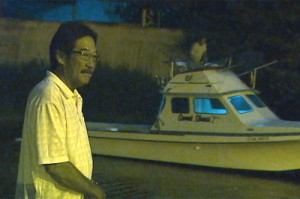
Hilo residents work to pull boats from the water before a predicted tsunami arrives on Saturday night.
Video by David Corrigan
HILO, Hawaii: If you live on the east side of the Big Island and you think Saturday night’s tsunami sirens sounded a little late – in many cases after you were alerted to the tsunami warning from alternate sources – you are not alone.
Reports of “late” tsunami sirens flooded the internet and radio airwaves in the hours before the surge was expected to hit. Most accounts agree that sirens in Hilo were sounding by 9 p.m., but by that time Kona had reportedly heard the alarm go off four or five times. Douglas Pacheco, helping his brother-in-law pull vessels from the water at the Wailoa Small Boat Harbor before the waves hit, spoke to us about the first siren he heard in Hilo, only an hour and a half before the predicted surge. There were similar accounts from residents in Puna and Hamakua.
Hawaii County Mayor Billy Kenoi confirmed that there were some issues with the system on Saturday night, but no details were given. The mayor said the problems were fixed.
A media release issued on Sunday had a little more information:
Although there were technical challenges initially with our siren system during last night’s tsunami warning, the challenges were addressed. The sirens are just one facet of our comprehensive emergency notification strategy, which includes sounding sirens, sending phone, text, and email alerts through mass notification systems, Civil Defense messages on radio and television stations, and manual notification by Police, Fire, and Civil Air Patrol.
Police and Fire personnel were deployed immediately to shoreline areas to notify people of the evacuation. Two fire helicopters, a privately contracted helicopter, and a Civil Air Patrol plane were in the air to monitor the shoreline and further notify people in difficult to access shoreline areas and ensure that the areas were clear.
Our human response was executed according to plan. In spite of the technical challenges earlier in the evening, we were able to safely execute a complete island-wide evacuation of shoreline and low-lying areas by 10:05 p.m.
The lack of an early siren didnt seem to hamper the evacuation of seaside towns like Keaukaha, which makes its escape through the closed Hilo Airport runway. It is a drill that the seaside village practices often.
The mayor credited the large emergency force working on the ground to help residents with Saturday’s smooth evacuation, despite the apparent siren snafu.
The county also promised to station personnel at all sirens during the monthly test on November 1st, “to ensure that they are operating as expected in concert with Hawaii State Civil Defense.”
State Civil Defense owns the sirens and takes care of repairs, while Hawaii County Civil Defense coordinates the operation of the sirens and conducts monthly tests.

by Big Island Video News11:55 am
on at
STORY SUMMARY
Video by David Corrigan HILO, Hawaii: If you live on the east side of the Big Island and you think Saturday night’s tsunami sirens sounded a little late – in many cases after you were alerted to the tsunami warning from alternate sources – you are not alone. Reports of “late” tsunami sirens flooded the […]